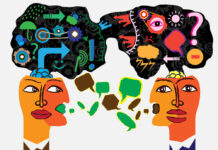A recent article published in the journal Psychopathology argues that “schizophrenic experiences” are best understood as intersubjective and social rather than exclusively individual.
German authors Samuel Thoma, Isabelle Schwänzl, and Laura Galbusera believe that openness to the world—or lack thereof—is a primary factor in “schizophrenic experiences.” They argue that therapeutic approaches conducive to the rehabilitation of a closed down world-openness, such as Open Dialogue, should be advocated in psychiatry and psychology.
“Classical and contemporary phenomenological approaches in psychiatry describe schizophrenia as a disorder of common sense and self-affection. Although taking into account intersubjectivity, this conceptualization still puts forward an individualistic view of the disorder, that is, the intersubjective deficit resides within the person,” writes Thoma, Schwänzl, and Galbusera. “We propose that schizophrenic experience might be understood as arising from a dialectic relation between the self’s loss of openness to the world and the world’s loss of openness to the self.”

Despite a significant amount of research suggesting that the development of “schizophrenia” is related to several social and interpersonal factors and that recovery is also dependent on the social world, the predominant biomedical paradigm still fails to account for its social origins and effective treatments.
The current paper argues for a conceptualization of “schizophrenic experience” that is grounded in understanding how intersubjective and social factors inform what we call “schizophrenia.” The authors oppose more individualistic frameworks that put the onus of both development and recovery on the “sick” person.
They focus on a phenomenological account of “trigger situations” related to the onset of schizophrenic experiences, in addition to making suggestions for treatment modalities that might better address the underlying and inherently social difficulties of these experiences.
The authors first argue that in “trigger situations”—those situations which can lead to the onset of schizophrenic experiences—there is often a “closing down of the world” for the person.
In one historical clinical example from the existential psychiatrist Ludwig Binswanger:
“Urban describes a crucial moment that occurred at the beginning of her schizophrenic episode: She was sitting in a doctor’s room, witnessing the doctor’s examination of her husband, who suffered from cancer. Urban was very dependent on her husband.
In that moment, the doctor gave her a look of dread, which expressed the bad result of the examination and implied the possibility that her husband would die. This look had a profound effect on her, affecting her most intimate self and its fundamental sympathetic communication with the world. The entire scene seems suddenly filled with a threatening and uncanny atmosphere, leaving no space for her to move or escape.”
Describing these and other case examples, the authors note that they often involve a traumatic “impossibility of expression in response to a threatening situation.”
Of course, “schizophrenia” is often related to a series of chronic experiences rather than a singular one.
The authors describe the relationship between schizophrenic diagnosis and being a refugee as one example here: “one could suppose that members of a minority group do not share the common sense of a majority group, which may result in a constant interactional crisis due to the lack of a shared ‘natural evidence.’”
Racism and other forms of discrimination, known to increase the likelihood of schizophrenic experiences, may follow a similar logic.
They note that the gaze of another person, or society at large, can play a role here. In the example provided earlier, the gaze of the doctor was experienced as oppressively restrictive. The “torturous” gaze may relate to:
“At the onset of psychosis, the world seems to have lost its receptivity and habitability, that is, the open space for a self to move or even to be. One could thus conclude that, as a therapeutic consequence, the communication, and the world’s openness, that is, its room to move and room to exist, need to be restored.”
Turning to the second section, the authors describe treatment modalities that both “close down” people’s worlds as well as those that can begin to restore this “room to move and room to exist.”
Among the modes of treatment that they deem to reinforce the “closing down” of the person’s world, which they again believe constitutes a major element of schizophrenic experiences, are “closed wards, diagnostic labeling (with the associated phenomenon of stigma), and coercive treatment.”
One of the problems with wards, for example, is how it both physically and experientially presents an “enclosure” that individuals must remain within. This is literal and physical in cases where people may not leave the clinical setting. However, it is also experiential, in the sense that individuals are required to obey the institution’s procedures, and their actions and statements (for example, treatment resistance) are consistently interpreted as further evidence of their psychopathology.
In terms of diagnostic labeling, the authors relay a clinical story from their practice:
“A person diagnosed with schizophrenia, who we here call O., reported that he was once told by one of our colleagues: “I’m afraid you won’t make it without life-long medication.” Despite hearing voices from time to time, O. has lived without medication for the last few years, and he told us about the very violent impact this professional assessment had on him.
Even if expressed with good intentions by our colleague, this assessment felt to him like an omen haunting him for the rest of his life: Would it turn out to be right if, by not taking medication, he somehow ended up “failing” in his life? What would “not making it” mean?”
In cases like these and others where this is a stigma associated with psychiatric labeling—even unintentional—there can be an “enclosing” of experience. In other words:
“Could not the phenomenological diminishment of self-described in schizophrenia also (or at least in part) be related to the diminished and stigmatizing experience of self-given by this very diagnosis?”
As far as coercion is concerned, the authors state that things like physical confinement and medical restraint in the form of sedatives can “replace” the openness of reciprocal human relations. These practices can reinforce the “enclosing” of psychological experience found at the core of schizophrenic experiences.
Turning, finally, to what the authors view as “open” or “opening” spaces for treatment, they state that “a therapeutic aim should be to support a reopening of the patient’s self by providing a secure, shared, and open therapeutic space.”
Alongside advocacy toward “open wards,” opposing involuntary confinement, the authors describe specific modalities like Open Dialogue as having the potential to provide those secure, shared, and open therapeutic spaces.
Open Dialogue, for example, focuses on flexible “network meetings” which can involve psychological professionals, service users, and family members or close friends. A dialogue is then encouraged between these parties without strict, top-down authoritarian practices, as you might find in some conventional psychiatric settings. Instead, the emphasis is on “polyphony,” or the “inclusion and mutual understanding of different narratives and voices.”
For the authors, this celebration of mutual acceptance and tolerance of difference is essential for the stance of any professional attempting to aid in a “re-attunement of selves.” This idea here is that this stance can encourage new frontiers of experience of self, new experiences of openness, against the enclosure and disconnectedness of schizophrenic experiences.
The authors conclude:
“Another promising and much-needed focus of research is on the therapeutic stance of professionals in the different psychiatric spaces and settings, which the authors of this article currently examine in an ongoing qualitative research project. Preliminary results of this study show that one recurring motive of professionals’ therapeutic stance towards persons with psychosis might be the capacity to empathize with psychotic experiences or even to consider them as one’s own existential possibility.
Whereas the qualities and effects of such a therapeutic stance of professionals still need to be investigated in more detail, we firmly believe that the relevance of such stance should not be restricted to the mental health and psychotherapy settings, but it is also crucial at a broader societal level. Indeed, the loss of dialogical connection to the social world that persons with schizophrenia experience are still and all too often mirrored by society’s loss of dialogue with them.”
****
Thoma, S., Schwänzl, I., & Galbusera, L. (2021). Reopening selves: Phenomenological considerations on psychiatric spaces and the therapeutic stance. Psychopathology, 1-12. (Link)















And where exactly are these social, open treatments available? Having a loved one in the mental health system for several years now I do not see it.
Report comment
Hemingway, great question!! I think the journal article that this article references is actually cutting-edge. When they discuss open-treatment, I believe they mean it as a suggestion for further research and proliferation. Overall, it seems like an amazing idea doesn’t it? As someone who used to hear voices and spent almost a year in institutional settings, I cannot even describe how “open-treatments” eventually led me to recovery. In hindsight, they also could have allowed a speedier, more effective recovery. I wish you the best on your journey with your loved one
Report comment
Sometimes I read articles here that make me cry – this is one such. I cry out of hope. I think this text holds something very true, that I can relate to from experiences of having been in the state called psychosis, that loss of everything ordinary and a place in the world. All I wished was to get back some ordinariness in my existence. It is very hard, when what is left of sense of identity and agency is also questioned or even taken away by psychiatric treatment.
Report comment
“We propose that schizophrenic experience might be understood as arising from a dialectic relation between the self’s loss of openness to the world and the world’s loss of openness to the self.”
My psychologist believed that having my innocent baby denied a baptism three times, at the exact same time as the World Trade center buildings were falling, was distress caused by a “chemical imbalance” in my brain alone. Unfortunately my psychologist didn’t explain her odd belief system to me, until I was picking up her medical records.
This “holistic Christian talk therapist” proceeded to misdiagnose a common symptom of antidepressant discontinuation syndrome (“brain zaps”), worsened by a dirty opioid, as “bipolar.” She also claimed, in her medical records only, that a dream about being moved by the Holy Spirit was a “Holy Spirit voice,” and proof of “psychosis.” Actually, that’s blasphemy of the Holy Spirit, and the only unforgivable sin in the entire Holy Bible.
But I will say the traumatic events of that morning did destroy my trust in – “openness to”- my childhood religion (although it did not destroy my belief in the Triune God). And the traumatic events of 9/11/2001 were distressing to me, as a former New Yorker. However, I do think most of the rest of the world was distressed by 9/11/2001, too. And I’m quite positive the worldwide distress of that distressing day had less than zero to do with a “chemical imbalance” in my brain alone.
And once I’d read my psychologist’s medical records, and my family’s medical records, I learned my psychologist was actually a manic lunatic who’d gotten all her misinformation about me from pedophiles and her, what I consider to be a spiritual child abusing, pastor. It has since been confessed to me that the entirety of my childhood religion has “partnered with” the DSM “bible” billers, and the DSM “bible” billers apparently function as the systemic child abuse covering up arm of my childhood religion.
https://www.indybay.org/newsitems/2019/01/23/18820633.php?fbclid=IwAR2-cgZPcEvbz7yFqMuUwneIuaqGleGiOzackY4N2sPeVXolwmEga5iKxdo
https://www.madinamerica.com/2016/04/heal-for-life/
https://books.google.com/books?id=xI01AlxH1uAC&printsec=frontcover&source=gbs_ge_summary_r&cad=0#v=onepage&q&f=false
Which means that the so called “delusional religious conspiracy,” that my psychologist fraudulently accused me of knowing something about, is actually a systemic medical / religious “conspiracy.” And it is a medical / religious “conspiracy” with a name, according to an ethical pastor of a different religion, who called it “the dirty little secret of the two original educated professions.”
“The authors oppose more individualistic frameworks that put the onus of both development and recovery on the ‘sick’ person.”
I agree. Especially given the fact that the “schizophrenia treatments,” the antipsychotics / neuroleptics, can create “psychosis” via anticholinergic toxidrome. And they can also create the negative symptoms of “schizophrenia,” via neuroleptic induced deficit syndrome. Which would imply “schizophrenia” is likely largely an iatrogenic, not “genetic” illness, that can be created with the “gold standard treatments.”
“The authors first argue that in ‘trigger situations’—those situations which can lead to the onset of schizophrenic experiences—there is often a ‘closing down of the world’ for the person.”
Yes, I did somewhat feel like there was a ‘closing down of the world’ – or a destruction of the world I knew – on the morning of 9/11/2001. Given that morning was a destruction of my trust in my childhood religion, and a destruction of the city I grew up near. Although, in my case, my “psychosis” did not happen until after I’d been anticholinergic toxidrome poisoned months later, not right after 9/11/2001.
“Among the modes of treatment that they deem to reinforce the ‘closing down’ of the person’s world, which they again believe constitutes a major element of schizophrenic experiences, are ‘closed wards, diagnostic labeling (with the associated phenomenon of stigma), and coercive treatment.'”
Absolutely true. Stealing one’s freedom, defaming people with scientifically “invalid” disorders, and force neurotoxic poisoning people is 100% the opposite of helping someone.
http://psychrights.org/2013/130429NIMHTransformingDiagnosis.htm
“one recurring motive of professionals’ therapeutic stance towards persons with psychosis might be the capacity to empathize with psychotic experiences or even to consider them as one’s own existential possibility.”
The problem is that after the psychiatrist I was shipped to anticholinergic toxidrome poisoned me, and made me “psychotic,” my psychiatrist told me to ignore the “voices” that he had created. And never once did he consider the “voices” as relating to my real life concern for my abused child, which they did. Nor did my “holistic Christian talk therapist” or psychiatrist consider my Spiritual dream to possibly relate to “one’s own existential possibility,” or as part of a possible Spiritual journey, as it seemed to me.
“the loss of dialogical connection to the social world that persons with schizophrenia experience are still and all too often mirrored by society’s loss of dialogue with them.”
My psychologist and psychiatrist defamed me to my family, but not my friends, so thankfully I did not experience a “loss of dialogue” with my friends. And since anticholinergic toxidrome makes one “hyperactive,” not “inactive,” I did stay very busy working with my friends. But, of course, my psychologist’s and psychiatrist’s misdiagnosis and defamation of me to my family did destroy my marriage, was taxing on my other familial relations for many years, and did make speaking to – or taking the advise of – my psychologist and psychiatrist “irrelevant to reality” for me.
I do agree Open Dialogue would be a much better paradigm, the “invalid” DSM billing code “bible” should be flushed, and forced and/or coerced medical treatment of any kind should be outlawed.
Report comment
When a person is in a so-to-speak impossible situation, the cure/solution is a possible situation. Yeah, sure. I think it takes social changes to give people the back the chances they might have been deprived of having in life. No chance. Not much potential in that, is there?
Report comment
May I propose a radical paradigm:
There is no loss of openness of the person who is suffering from schizophrenia who is coming to get help. Getting help is an act of openness already. Getting dismissal, diagnosis, undermining of one’s subjectivity and mind is closeness.
The flip side and where the problem can only be solved is: can the medical industry be open consciously and willing to allow themselves to learn, to listen, to give credence of the person they are treating rather than wanting that person do to what they want “openness” or not.
I know it is difficult to ask the medical groups to open up to the unknown to become less expert on everybody’s mind…but that is precisely why it is even more challenging to ask a person suffering supposedly from closeness to the masses to do exactly what the medical personnel do not or can’t do themselves.
The closeness is the system not the individual coming to the system. The major oppressor machine of this extremely difficult condition is language. We use language against them rather than open to them.
The old quote: If you look at each word, you will see the impersonalization of the experience
“We propose that schizophrenic experience might be understood as arising from a dialectic relation between the self’s loss of openness to the world and the world’s loss of openness to the self.”
Now let me re-phrase this:
We propose that a person with schizophrenic experience might be understood as arising from a dialectic relation between the system’s/culture/etc loss of openness to the world and the world’s loss of openness to the individual with schizophrenic experience.
Let us try that now using some imagination.
Report comment
Anyone think it will be easier or more fulfilling to socialize if people think you have an ill brain just like diabetes or cancer? It’s no surprise people with these diagnoses isolate. When socializing means being reminded people think what you are is an illness socializing results in suffering. Will your self esteem worsen or improve if you believe what makes you you is an illness? No wonder people with these labels feel worthless; society has yelled in their face that they are worthless. Would someone be more or less motivated to improve their life if their problems are caused by a chemical imbalance? Self induced activities and effort can’t fix what’s wrong because what’s wrong is chemicals in the brain that are fixed with drugs. Psychiatric diagnosis operate as self-fulfilling prophecies. They violate the principle of “first do no harm”
Report comment